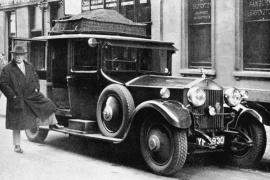Segment: Luxury
Production years: 1925, 1926, 1927, 1928, 1929, 1930, 1931

In 1925, Rolls-Royce replaced the successful Silver Ghost with the New Phantom, which was later known as the Phantom I since other vehicles that came from the British brand wore the same nameplate.
Replacing a highly appreciated luxury vehicle such as the Silver Ghost was not an easy job, and Rolls-Royce knew that it had to do something great to convince its picky customers that the change was worth it. In an era where those vehicles were among the most expensive in the world, its deep-pocket customers expected nothing but the best in terms of elegance, performance, reliability, and comfort. As a result, the British car manufacturer had to create an excellent platform and then cooperate with famous coachbuilders to complete the bodywork at customers’ requests, and that’s exactly what Rolls-Royce did.
Since the British automaker knew that it had many customers in the U.S., it also built the Phantom in Springfield, Massachusetts. While there were some differences between cars made in the UK and in the States, the quality was the same. Furthermore, the British car manufacturer bought the American coachbuilder Brewster & Co. in 1926 to ensure high bodywork quality. Vehicles built in Derby were completed by various coachbuilders, such as Park Ward, Barker, Mulliner, Zagato, and others.
Rolls-Royce had already gained a high reputation among car manufacturers for creating extraordinary vehicles and aimed to improve constantly. As a result, the Phantom, later known as the Phantom I, got a new inline-six engine with overhead valves instead of side-mounted ones. In addition, the twin spark plugs per cylinder system ensured that the engine could run smoother. That system was needed due to the big bore of the cylinders and the fact that the ignition was not that much evolved in those times. The 100 BHP (101 PS) powerplant had a 7.7-liter displacement.
The sturdy chassis was supported by a beam axle and double semi-elliptic leaf springs at the front and a live rear axle with leaf springs out back. Vehicles made in Springfield were fitted with a three-speed manual gearbox, while those coming from Derby relied on four-speed manuals. Stopping power was provided by drum brakes on both axles.
Regardless of their assembly plant, all vehicles came with the same upright, tall silver radiator grille, and its louvers could be opened and closed via a switch mounted on the dashboard. On top of it stood the proud Spirit of Ecstasy. The big round headlights supported on a horizontal bar could swing downwards via a lever mounted next to the driver’s seat. In front of the driver, the automaker installed a flat wooden dash panel that sported the speedometer, the tachometer, and several other gauges. U.S. versions even had a fuel-level gauge on them, while those coming from Derby had that gauge mounted on the tank.
ROLLS-ROYCE Phantom I 1925, 1926, 1927, 1928, 1929, 1930, 1931
- 7.7
ROLLS-ROYCE Phantom I
7.7
ENGINE SPECS - 7.7 | |
|---|---|
| Cylinders: | L6 |
| Displacement: | 7668 cm3 |
| Power: | 70 KW @ 2750 RPM 95 HP @ 2750 RPM 94 BHP @ 2750 RPM |
| Fuel System: | Carburetor |
| Fuel: | Gasoline |
PERFORMANCE SPECS | |
|---|---|
| Top Speed: | 90 mph (145 km/h) |
TRANSMISSION SPECS | |
|---|---|
| Drive Type: | Rear Wheel Drive |
| Gearbox: | Manual, 4 Speed |
BRAKES SPECS | |
|---|---|
| Front: | Drums |
| Rear: | Drums |
TIRES SPECS | |
|---|---|
| Tire Size: | 7.00x21 |
DIMENSIONS | |
|---|---|
| Length: | 219 in (5563 mm) |
| Width: | 72 in (1829 mm) |
| Front/rear Track: | 58/58 in (1,473/1,473 mm) |
| Wheelbase: | 144 in (3658 mm) |
